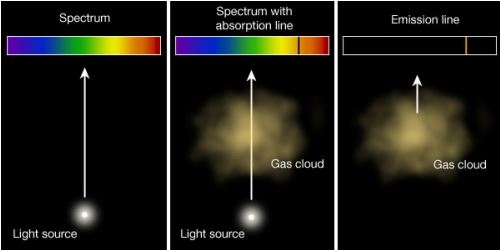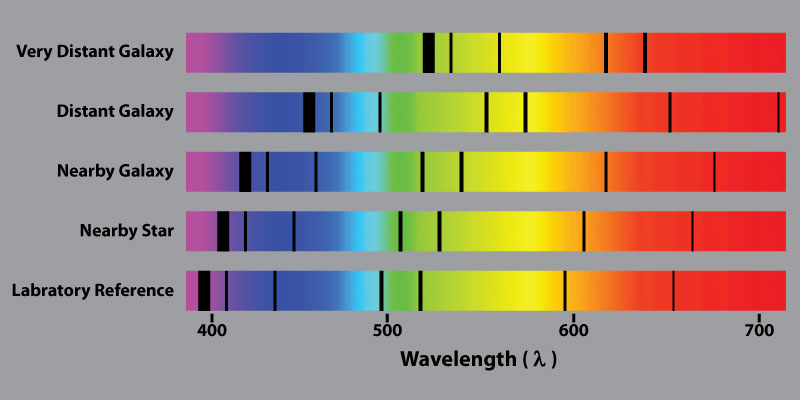In 1997, an afterglow associated with a gamma ray burst was discovered by the Italian satellite BeppoSAX. The afterglow corresponds to the extension of the emission into the X-ray, visible and radio domains, immediately after the flash in gamma-rays (the prompt emission). This discovery was essential because it enabled scientists to determine for the first time the distance of a burst and the physical properties of its surrounding environment. This opened up a new field of research to the scientific community. While the prompt emission lasts only a few seconds, the afterglow persists for a longer period of time, hours or days depending on the wavelength range. This has an immediate consequence; the afterglow can be studied in detail in the visible and infrared by telescopes on the ground provided they have a refined position of the source in the sky. Spectroscopic studies are a key point at this stage because they provide a wealth of diverse information on the distance, the properties of the burst’s environment, the type of host galaxy, and the nature of the media probed by the light during its journey to Earth. Therefore spectroscopy is an extremely powerful and indispensable measurement tool in order to use bursts as probes of the distant universe.
Spectral lines
A spectrometer placed at the end of a telescope makes it possible to decompose the light of the observed source in order to establish its spectrum. The spectrum of a source acts as a fingerprint revealing its true identity.

It is characterized by the presence of spectral lines, situated at specific wavelengths depending on the chemical elements of the source. By analyzing the spectrum of a medium, it is therefore possible to determine the chemical composition of the observed object. These spectral lines can be of two natures. When they come from an ionized gas, like the gas of the interstellar medium heated by the radiation of stars, they are observed in emission. For example, the lines of ionized hydrogen and oxygen are commonly observed in the spectra of galaxies where significant stellar formation is taking place. Conversely, if the light of the observed source passes through clouds of neutral gas, the chemical elements in the cloud can absorb some of the photons, and lines appear in the spectrum: the lines are then observed in absorption. In the case of gamma-ray bursts, the spectral analysis of the afterglow emission reveals in a quasi-systematic way a multitude of absorption lines coming from all the absorbing media crossed by the light of the burst. These absorbers include the gas of the circumburst environment and the interstellar medium of the host galaxy, as well as absorbers beyond the host galaxy, located between the burst and Earth. The spectral analysis of afterglows thus provides crucial information not only on the chemical composition of the environment in which the gamma-ray bursts occur, but also on the properties of galaxies and their evolution at different epochs of cosmic history.
The Doppler effect or using redshift to measure distance
The wavelength of a spectral line can also translate a motion of the emitting source : the Doppler effect. When an emitting source is moving towards the observer, its apparent wavelength becomes shorter, it is shifted on the spectrum. In the visible domain, this means that it shifts towards bluer wavelengths. Conversely, when the source moves away, its apparent wavelength increases. This is called redshift, and the faster the source moves, the greater the spectral shift. This property is particularly interesting in astronomy, since the expansion of the Universe leads to a redshift of the spectra of galaxies. The magnitude of this redshift is directly related to the distance of the observed source. This is the law discovered by Edwin Hubble in 1929. Thus, each absorbing system crossed by a gamma-ray burst produces spectral lines in the spectrum of the afterglow, and the wavelength shift of these lines allows us to measure the distance to the medium responsible for the absorption. In particular, the very first absorber encountered by the light of the burst is the gas present in its close environment and has the largest spectral offset.

The redshift ideally allows scientists to identify the galaxy in which the burst took place. It is measured by the absorption lines of the afterglow emission. The redshift obtained by the emission lines of the host galaxy detected after the disappearance of the afterglow is generally identical to the one measured in absorption. This method confirms that this is the host galaxy. Detection is only the starting point of astronomy. Beyond the simple observation of a luminous point, it is necessary to be able to describe what constitutes these distant environments and to perhaps deduce the conditions under which gamma-ray bursts form. Spectroscopy can thus, depending on the scale, allow us to know the atmosphere close to a star, a planet, what a galaxy, or even what the primordial matter that appeared just after the Big Bang is made of.



